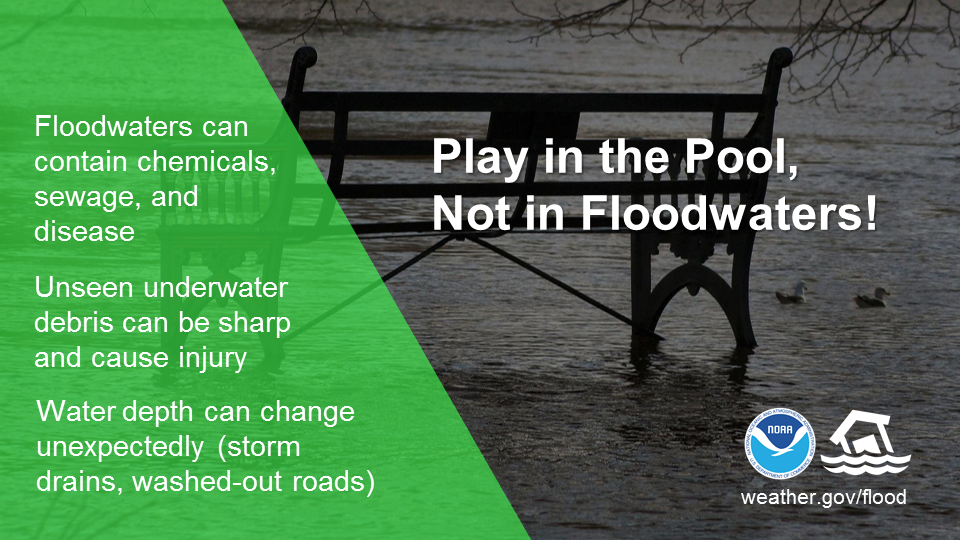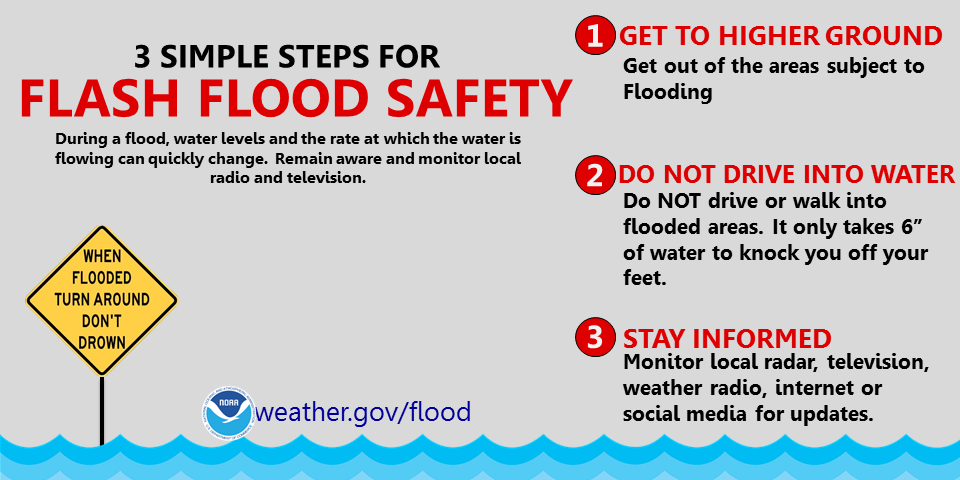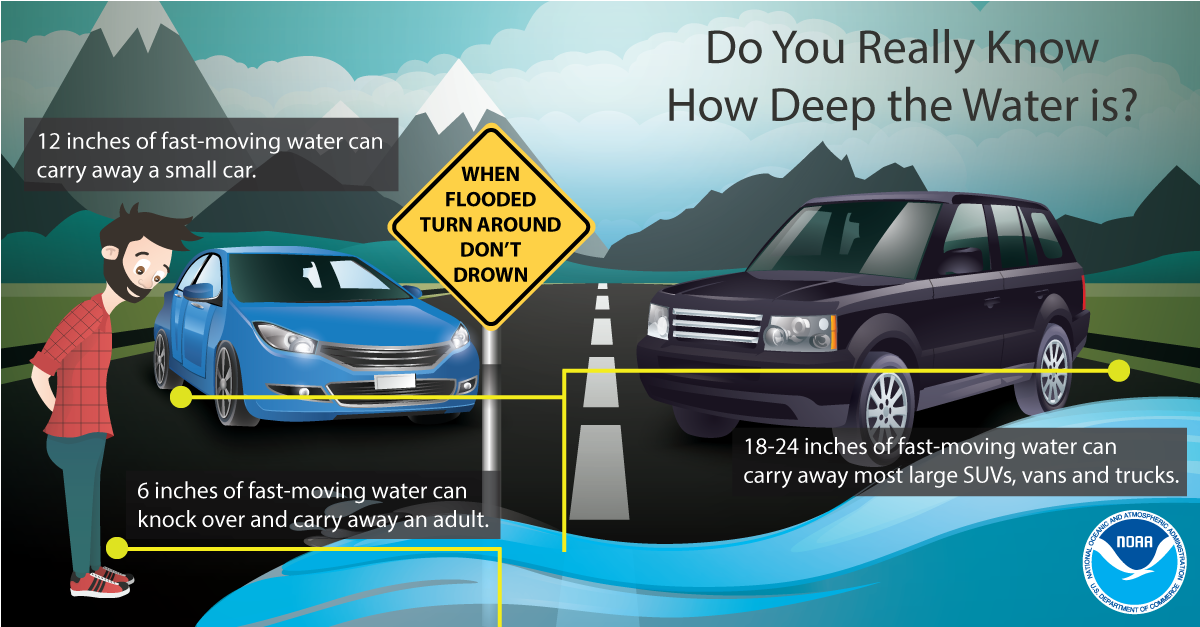Please help the NWS spread these important safety messages on social media! Everyone is welcome to use the text and images provided below to help the NWS build a Weather-Ready Nation.
Facebook
"I would have surely lost the vehicle and maybe our lives...just saying 'Turn Around Don't Drown' saved life and property."
You never know how deep the water is. weather.gov/safety/flood-turn-around-dont-drown #FloodSafety
Twitter
"I would have surely lost the vehicle and maybe our lives...just saying 'Turn Around Don't Drown' saved life and property."
You never know how deep the water is. weather.gov/safety/flood-turn-around-dont-drown #FloodSafety

Facebook
Play in the pool, not in floodwaters! Floodwaters can contain harmful chemicals and objects that could harm you or make you sick. #FloodSafety http://www.noaa.gov/resource-collections/watersheds-flooding-pollution
Twitter
Floodwaters can contain chemicals or objects that could harm you or make you sick. #FloodSafety http://www.noaa.gov/resource-collections/watersheds-flooding-pollution

Facebook
Heavy rainfall always brings a danger of flash flooding, but sometimes even light/moderate rainfall can trigger dangerous floods. Dry stream beds can become raging torrents in minutes with no rain in sight! Stay safe from floodwaters and learn more at http://www.weather.gov/media/wrn/floods_booklet.pdf#page=3
Twitter
Get swept away and learn about the awesome power of floods at http://www.weather.gov/media/wrn/floods_booklet.pdf#page=3 #FloodSafety

Facebook
A flood WARNING means TAKE ACTION. A flood WATCH means BE PREPARED. When a Warning occurs, it means flooding is imminent or already occurring. When a Flood Watch is in effect, it means flooding is possible in your area. weather.gov/safety/flood-watch-warning #SummerSafety #FloodSafety
Twitter
Warning means TAKE ACTION. Watch means BE PREPARED. weather.gov/safety/flood-watch-warning #FloodSafety #SummerSafety

Facebook
During a flood, water levels and the rate at which the water is flowing can quickly change. Get to higher ground. Do not drive or walk into water. It only takes 6 inches of water to knock you off your feet. Stay informed by monitoring local radio and television for updates. weather.gov/flood #FloodSafety #SummerSafety
Twitter
During a flood, water levels and the rate at which the water is flowing can quickly change. weather.gov/flood #FloodSafety #SummerSafety

Facebook
NEVER drive around barricades into floodwaters! More than 50% of all flood fatalities are vehicle-related. It only takes 12 inches of fast-moving water to carry off a small car and 18 inches of water to sweep a larger vehicle away. Turn Around Don’t Drown! weather.gov/safety/flood-turn-around-dont-drown #FloodSafety #SummerSafety
Twitter
Half of all flood fatalities are vehicle-related. Turn Around Don’t Drown! weather.gov/safety/flood-turn-around-dont-drown #FloodSafety #SummerSafety

Facebook
Don’t underestimate the power of water. It only takes 6 inches of fast-moving water to knock over and carry away an adult, 12 inches to carry away a car, and 18-24 inches to carry away most large SUVs, vans and trucks. Turn Around Don’t Drown! weather.gov/safety/flood-turn-around-dont-drown #FloodSafety #SummerSafety
Twitter
Don’t underestimate the power of water. Turn Around Don’t Drown! weather.gov/safety/flood-turn-around-dont-drown #FloodSafety #SummerSafety

Facebook
NEVER drive or walk into floodwaters. It is impossible to know how deep the water is just by looking at it. Turn Around Don’t Drown! weather.gov/safety/flood-turn-around-dont-drown #FloodSafety #SummerSafety
Twitter
It is impossible to know how deep the water is just by looking at it. Turn Around Don’t Drown! weather.gov/safety/flood-turn-around-dont-drown #FloodSafety

Facebook
Driving into floodwaters could be the last decision you ever make. Turn Around Don’t Drown! https://youtu.be/eI6mIlHKrVY #FloodSafety #SpringSafety
Twitter
Driving into floodwaters could be the last decision you ever make. Turn Around Don’t Drown! https://youtu.be/eI6mIlHKrVY #FloodSafety

Facebook
A Flood Watch means BE PREPARED. When a Flood Watch is in effect, it means flooding is possible in your area. During a Flood Watch, check the forecast regularly, and be prepared to move to higher ground. weather.gov/safety/flood-watch-warning #FloodSafety #SummerSafety
Twitter
A Flood Watch means BE PREPARED. weather.gov/safety/flood-watch-warning #FloodSafety #SummerSafety

Facebook
A Flood Warning means TAKE ACTION NOW! When a Flood Warning is issued, it means flooding is imminent or already occurring. Move to higher ground immediately, and use extra caution if driving. weather.gov/safety/flood-watch-warning #FloodSafety #SummerSafety
Twitter
A Flood Warning means TAKE ACTION NOW! weather.gov/safety/flood-watch-warning #FloodSafety #SummerSafety

Facebook
Are you planning to camp or hike near a stream or river? Remember that it doesn’t have to rain directly over you for there to be flooding. If you notice even a slight rise in water level, seek higher ground immediately! weather.gov/safety/flood-during #FloodSafety #SummerSafety
Twitter
Thunderstorms far away can cause flooding downstream. weather.gov/safety/flood-during #FloodSafety #SummerSafety

Facebook
More than 50% of all flood fatalities are vehicle-related. You never know how deep the water is or if the road has been washed away or compromised beneath the water. Don’t risk driving into floodwaters. Turn Around Don’t Drown! weather.gov/safety/flood-turn-around-dont-drown #FloodSafety #SummerSafety
Twitter
More than half of all flood fatalities are vehicle-related. Turn Around Don’t Drown! weather.gov/safety/flood-turn-around-dont-drown #FloodSafety #SummerSafety

Facebook
Flooding can occur during any time of the year. As a result, it’s always best to be prepared! To learn more about flooding and how you can prepare before it happens, visit weather.gov/flood. #FloodSafety #SummerSafety
Twitter
Flooding can occur anytime of the year. Be prepared, visit weather.gov/flood #FloodSafety #SummerSafety

Facebook
Debris flows often happen in areas where excessive rain causes soil to become so saturated it turns into very runny mud. The mud then races downhill, picking up debris such as fallen branches, tree trunks and rocks as it goes. Debris flows can bury homes under piles of mud and debris. Know the risks of the area where you live, so you can prepare your family and home before heavy rains threaten your area. weather.gov/safety/flood-hazards #FloodSafety #SummerSafety photo:FEMA
Twitter
Debris flows can bury homes under a pile of mud and debris. Learn more: weather.gov/safety/flood-hazards (photo: @fema)

Facebook
If you live, work or are spending recreational time outside near an area recently affected by a wildfire, keep in mind that it will not take much rainfall to cause flooding. Land that was recently burned by a wildfire is called a “burn scar”, and when rain falls over a burn scar, the ground is unable to absorb much of the water, which often results in flash flooding.
weather.gov/safety/flood-hazards #FloodSafety #SummerSafety photo:FEMA
Twitter
Land burned by wildfire is at risk for flash flooding. weather.gov/safety/flood-hazards #FloodSafety (photo: @fema)

Facebook
Six inches of swiftly moving water can knock an adult off his or her feet. Turn Around Don’t Drown! weather.gov/flood #FloodSafety #SpringSafety
Twitter
Six inches of swiftly moving water can knock an adult off his or her feet. Turn Around Don’t Drown! weather.gov/flood #FloodSafety #SpringSafety

Facebook
When you drive into floodwaters, you’re not only putting your own life at risk, but also the lives of your rescuers. It’s far better to be late to work or to an appointment and remain safe, than to take a risk and possibly lose your life. Turn Around Don’t Drown! weather.gov/flood #FloodSafety #SummerSafety photo: FEMA
Twitter
You are putting your rescuers’ life at risk when you drive into floodwaters. weather.gov/flood #FloodSafety #SummerSafety (photo: @fema)

Facebook
It's important to know what kind of flooding you can expect in your area so that you know how to prepare. Visit weather.gov/safety/flood-map to find out what kind of flooding could impact your home! #FloodSafety #SummerSafety
Twitter
Know what kind of flooding you can expect in your area. weather.gov/safety/flood-map #FloodSafety #SummerSafety

Facebook
Your family may not be together when a disaster strikes so it is important to plan in advance. How will you get to a safe place? How will you contact one another? How and where will you get back together? What will you do in different situations? To find out how, visit https://www.ready.gov/make-a-plan #FloodSafety #SummerSafety Photo: FEMA
Twitter
How will you stay in touch during a disaster? Make a plan! https://www.ready.gov/make-a-plan #FloodSafety #SummerSafety(photo @fema)
